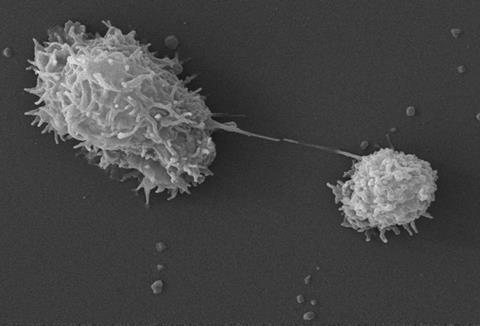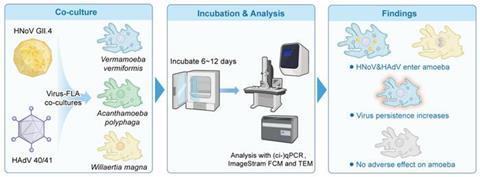A new study published in Water & Ecology reveals that common waterborne amoebae can ingest and protect human viruses, extending their environmental persistence.

Human norovirus (HNoV) and human adenovirus (HAdV)—major causes of acute viral gastroenteritis worldwide—are transmitted through contaminated water and food. The study shows these viruses can enter and persist within FLA, including Vermamoeba vermiformis, Acanthamoeba polyphaga, and Willaertia magna.
READ MORE: Free-living amoebae and emerging public health challenges in a warming world
READ MORE: Wily parasite kills human cells and wears their remains as disguise
“HNoV and HAdV can be internalized and persist inside FLA, which are highly abundant in all natural and man-made aquatic environments,” explains co-corresponding author Dr. Mats Leifels. “This potentially provides both enteric viruses with a protective vessel to bypass widely used water disinfection treatments such as UV, chlorine and monochloramine—methods that have already been suspected to be insufficient for removing high virus loads.”
Accumulating inside amoebae
Using quantitative PCR and fluorescence microscopy, the researchers observed HNoV accumulating in the cytoplasm and vacuoles of V. vermiformis and A. polyphaga, while HAd localized within the nucleus of W. magna. “Intact virions of both viruses persisted inside amoebae—including trophozoites, cysts, and extracellular vesicles—for up to 12 days,” shares Leifels. “HAdV retained infectivity after internalization, indicating that these viruses can evade amoebal digestion and structural degradation.”
In the case of HAdV, nuclear incorporation, preservation of capsid integrity and detection of mRNA associated with adenoviral fiber protein further suggest possible viral transcriptional activity within the amoebae hosts.

These findings challenge current assumptions about virus removal in water treatment processes food safety protocols and drinking water production. “FLA serve as reservoirs and transport vessels for enteric viruses. The enhanced persistence and protection conferred by ubiquitous FLA suggest a potential impact on microbial risk assessments for sewage-impacted rivers, lakes, and water reuse systems,” adds Leifels.
The study highlights the need to re-evaluate water and sanitation guidelines to better mitigate environmental transmission pathways.







No comments yet